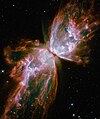
Size of this preview: 514 × 599 pixels. Other resolutions: 206 × 240 pixels | 412 × 480 pixels | 659 × 768 pixels | 879 × 1,024 pixels | 1,757 × 2,048 pixels | 3,527 × 4,110 pixels.
Original file (3,527 × 4,110 pixels, file size: 9.96 MB, MIME type: image/jpeg)
| This is a featured picture, which means that members of the community have identified it as one of the finest images on the English Wikipedia, adding significantly to its accompanying article. If you have a different image of similar quality, be sure to upload it using the proper free license tag, add it to a relevant article, and nominate it. |
| This image was selected as picture of the day on the English Wikipedia for February 20, 2011. |
File history
Click on a date/time to view the file as it appeared at that time.
| Date/Time | Thumbnail | Dimensions | User | Comment | |
|---|---|---|---|---|---|
| current | 12:46, 10 September 2009 |  | 3,527 × 4,110 (9.96 MB) | Friendlystar | {{Information |Description={{en|1=Butterfly Emerges from Stellar Demise in Planetary Nebula NGC 6302 The Wide Field Camera 3 (WFC3), a new camera aboard NASA's Hubble Space Telescope, snapped this image of the planetary nebula, catalogued as NGC 6302, bu |
File usage
The following pages on the English Wikipedia use this file (pages on other projects are not listed):
Global file usage
The following other wikis use this file:
- Usage on af.wikipedia.org
- Usage on ar.wikipedia.org
- مقراب هابل الفضائي
- سديم الفراشة NGC 6302
- فهرس كالدويل
- فهرس آر سي دبليو
- نقاش المستخدم:Salah Mhamdi/أرشيف 4
- ويكيبيديا:صور مختارة/الفضاء والكون/نظرة إلى الأعلى
- بوابة:علم الفلك/صورة مختارة
- كاميرا واسعة المجال 3
- ويكيبيديا:ترشيحات الصور المختارة/سديم الفراشة
- قائمة السدم الكوكبية
- ويكيبيديا:صورة اليوم المختارة/أبريل 2017
- قالب:صورة اليوم المختارة/2017-04-05
- بوابة:علم الفلك/صورة مختارة/24
- مستخدم:Eman 11223/ملعب
- ويكيبيديا:صورة اليوم المختارة/أكتوبر 2021
- قالب:صورة اليوم المختارة/2021-10-29
- Usage on az.wikipedia.org
- Usage on be.wikipedia.org
- Usage on bg.wikipedia.org
- Usage on bn.wikipedia.org
- Usage on br.wikipedia.org
- Usage on bs.wikipedia.org
- Usage on ca.wikipedia.org
- Usage on ce.wikipedia.org
- Usage on crh.wikipedia.org
- Usage on cs.wikipedia.org
- Usage on cv.wikipedia.org
- Usage on de.wikipedia.org
- Usage on diq.wikipedia.org
- Usage on el.wikipedia.org
- Usage on en.wikibooks.org
- Usage on en.wikinews.org
- Usage on en.wiktionary.org
- Usage on eo.wikiquote.org
- Usage on es.wikipedia.org
View more global usage of this file.




